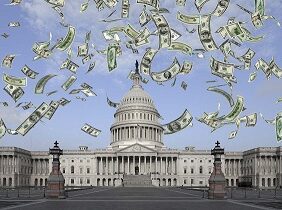Carbon Capture and Sequestration (CCS) is a suite of technologies that captures the carbon emitted during power generation and other industrial processes in order to store or utilize it. The process involves capturing carbon as it is emitted; and sequestering it, often deep underground, so that it is not immediately emitted into the atmosphere. Over decades, the federal government has provided billions of dollars in direct and indirect subsidies to support CCS technology and projects.
The carbon capture tax credit, known as 45Q, has a well-documented history of waste, fraud, and abuse. Between 2010 and 2019, 10 companies claimed $1.025 billion in tax credits under the federal 45Q carbon oxide sequestration tax credit. This accounted for 99% of all credits claimed under the program. Of these credits, the Internal Revenue Service (IRS) concluded that 90 percent, approximately $894 million, did not meet the Environmental Protection Agency’s (EPA) reporting requirements for sequestered carbon. Following examinations of 68 percent of these cases, the IRS disallowed 59 percent of the noncompliant credits, totaling around $531 million.[1] The full results of the examination have yet to be made available to the public.
More information is needed to understand if and how the tax credit is working. Taxpayers for Common Sense (TCS) has sought clarity from the IRS about its enforcement of 45Q through letters to the agency. Specifically, TCS has requested information on whether companies claiming 45Q credits adhered to the EPA Subpart RR requirements and reported the correct amount of carbon dioxide sequestered to the EPA. More specifically, TCS inquired about the submission and implementation of Monitoring, Reporting, and Verification (MRV) plans by these companies to the EPA. TCS has also requested a summary of the U.S. Treasury Inspector General for Tax Administration’s (TIGTA) findings and operations related to companies that have elected to comply with CSA/ANSI ISO 27916:2019 instead of EPA requirements, specifically whether companies have provided documentations and certifications compliant with IRS requirements as well as IRS enforcement actions against companies that are noncompliant. TCS also requested information on TIGTA’s plan for further oversight to ensure better compliance and accountability for 45Q.
The 45Q tax credit expansion in the Inflation Reduction Act raises red flags. Despite its documented history of fraud and abuse, and without clear details on actions taken to address these issues, the federal government has broadened the scope of the 45Q credit. Notably, this credit was expanded in the Inflation Reduction Act (IRA). The IRA raised the credit amount contingent on wage and apprenticeship prerequisites, lowered the carbon capture thresholds, and modified rules applicable to direct air capture and electric generating units, among other changes. The Joint Committee on Taxation estimates that the IRA’s extension and expansion of the 45Q credit could cost taxpayers $3.2 billion over the next decade and Treasury has estimated the cost of the 45Q credit over 10 years could be as high as 30.3 billion.[2][3] In the absence of strong compliance and anti-fraud safeguards, these credits will cost taxpayers billions of dollars without achieving their intended effects.
[1] “Memo to Sen. Robert Menendez” Inspector General for Tax Administration, April 15, 2020. https://www.menendez.senate.gov/imo/media/doc/
TIGTA%20IRC%2045Q%20Response%20Letter%20FINAL%2004-15-2020.pdf
[2] “Estimated Budgetary Effects of Public Law 117-169,” Congressional Budget Office (CBO), September 7, 2022. https://www.cbo.gov/system/files/2022-09/PL117-169_9-7-22.pdf
[3] “Tax Expenditures Fiscal Year 2024 – U.S. Department of the Treasury.” Department of the Treasury, March 6, 2023. https://home.treasury.gov/system/files/131/Tax-Expenditures-FY2024-update.pdf.











Get Social